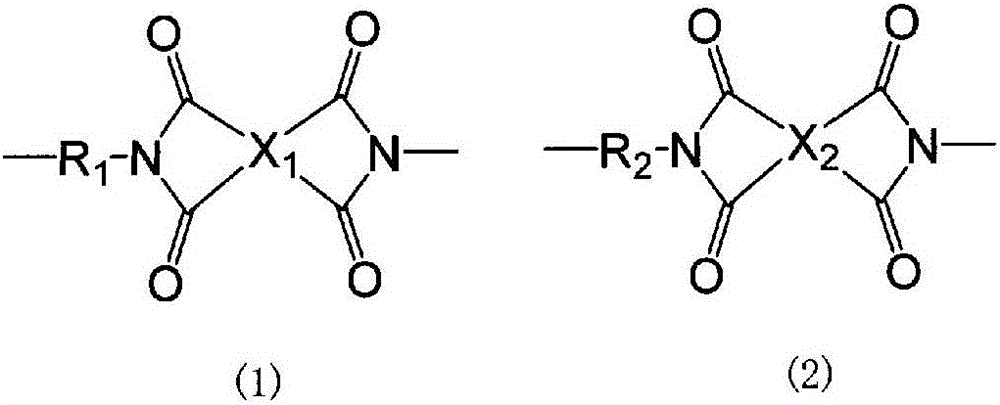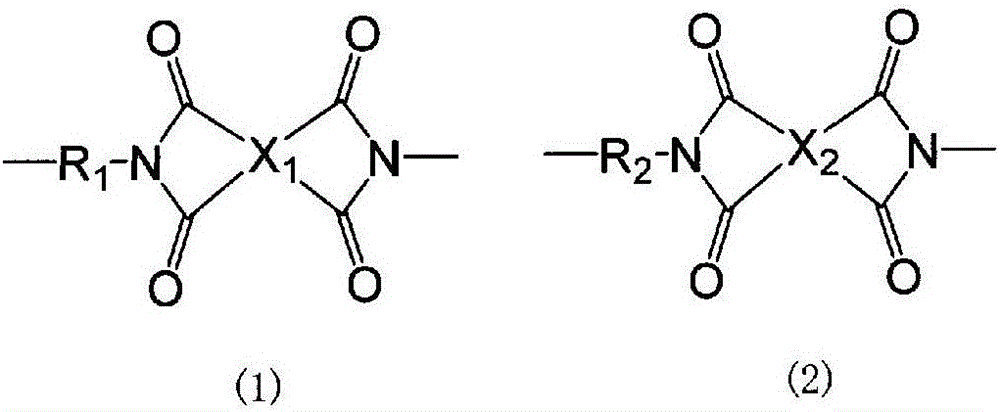Polyimide resin
A polyimide resin and alicyclic hydrocarbon technology, which is applied in the field of thermoplastic polyimide resin, can solve the problems of polyimide resin rigidity reduction, glass transition temperature reduction, melting point reduction, etc., and achieve excellent reflow Welding resistance, less decrease in strength, well-balanced effect
- Summary
- Abstract
- Description
- Claims
- Application Information
AI Technical Summary
Problems solved by technology
Method used
Image
Examples
Embodiment 1
[0271] [Example 1] Manufacture of polyimide resin 1
[0272] 600 g of 2-(2-methoxyethoxy)ethanol (manufactured by Nippon Emulsifier Co., Ltd.) was introduced into a 2L detachable flask equipped with a Dean-Stark apparatus, a Liebig condenser, a thermocouple, and 4 paddle blades and 218.58 g (1.00 mol) of pyromellitic dianhydride (manufactured by Mitsubishi Gas Chemical Co., Ltd.), and after flowing nitrogen gas, it was stirred at 150 rpm to make a uniform suspension solution. On the other hand, using a 500 mL beaker, 49.42 g (0.347 mol) of 1,3-bis(aminomethyl)cyclohexane (manufactured by Mitsubishi Gas Chemical Co., Ltd.), 1,8-octamethylenediamine (Kanto Chemical Co., Ltd. Co., Ltd.) 93.16 g (0.645 mol) was dissolved in 250 g of 2-(2-methoxyethoxy)ethanol to prepare a mixed diamine solution. The mixed diamine solution was slowly added using a plunger pump. During the dropwise addition of the mixed diamine solution, nitrogen flow was used, and the rotational speed of the stir...
Embodiment 2
[0276] [Example 2] Manufacture of polyimide resin 2
[0277]500 g of 2-(2-methoxyethoxy)ethanol (manufactured by Nippon Emulsifier Co., Ltd.) was introduced into a 2L detachable flask equipped with a Dean-Stark apparatus, a Liebig condenser, a thermocouple, and 4 paddle blades After 109.06 g (0.500 mol) of pyromellitic dianhydride (manufactured by Mitsubishi Gas Chemical Co., Ltd.), and flowing nitrogen gas, it stirred at 150 rpm, and was made into the uniform suspension solution. On the other hand, 21.18 g (0.149 mol) of 1,3-bis(aminomethyl)cyclohexane (manufactured by Mitsubishi Gas Chemical Co., Ltd.), 1,8-octamethylenediamine (Kanto Chemical Co., Ltd. Co., Ltd.) 50.12 g (0.347 mol) was dissolved in 200 g of 2-(2-methoxyethoxy)ethanol to prepare a mixed diamine solution. The mixed diamine solution was slowly added using a plunger pump. During the dropwise addition of the mixed diamine solution, nitrogen flow was used, and the rotational speed of the stirring blade was set...
Embodiment 3
[0279] [Example 3] Manufacture of polyimide resin 3
[0280] 500 g of 2-(2-methoxyethoxy)ethanol (manufactured by Nippon Emulsifier Co., Ltd.) was introduced into a 2L detachable flask equipped with a Dean-Stark apparatus, a Liebig condenser, a thermocouple, and 4 paddle blades After 109.06 g (0.500 mol) of pyromellitic dianhydride (manufactured by Mitsubishi Gas Chemical Co., Ltd.), and flowing nitrogen gas, it stirred at 150 rpm, and was made into the uniform suspension solution. On the other hand, using a 500 mL beaker, 17.65 g (0.124 mol) of 1,3-bis(aminomethyl)cyclohexane (manufactured by Mitsubishi Gas Chemical Co., Ltd.), 1,8-octamethylenediamine (Kanto Chemical Co., Ltd. Co., Ltd.) 53.70 g (0.372 mol) was dissolved in 200 g of 2-(2-methoxyethoxy)ethanol to prepare a mixed diamine solution. The mixed diamine solution was slowly added using a plunger pump. During the dropwise addition of the mixed diamine solution, nitrogen flow was used, and the rotational speed of th...
PUM
| Property | Measurement | Unit |
|---|---|---|
| melting point | aaaaa | aaaaa |
| glass transition temperature | aaaaa | aaaaa |
| molding temperature | aaaaa | aaaaa |
Abstract
Description
Claims
Application Information
 Login to View More
Login to View More - R&D
- Intellectual Property
- Life Sciences
- Materials
- Tech Scout
- Unparalleled Data Quality
- Higher Quality Content
- 60% Fewer Hallucinations
Browse by: Latest US Patents, China's latest patents, Technical Efficacy Thesaurus, Application Domain, Technology Topic, Popular Technical Reports.
© 2025 PatSnap. All rights reserved.Legal|Privacy policy|Modern Slavery Act Transparency Statement|Sitemap|About US| Contact US: help@patsnap.com



